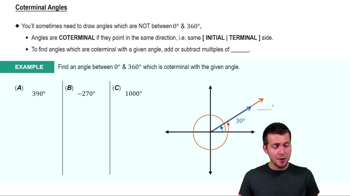Table of contents
- 0. Review of College Algebra4h 43m
- 1. Measuring Angles39m
- 2. Trigonometric Functions on Right Triangles2h 5m
- 3. Unit Circle1h 19m
- 4. Graphing Trigonometric Functions1h 19m
- 5. Inverse Trigonometric Functions and Basic Trigonometric Equations1h 41m
- 6. Trigonometric Identities and More Equations2h 34m
- 7. Non-Right Triangles1h 38m
- 8. Vectors2h 25m
- 9. Polar Equations2h 5m
- 10. Parametric Equations1h 6m
- 11. Graphing Complex Numbers1h 7m
1. Measuring Angles
Complementary and Supplementary Angles
Problem 20b
Textbook Question
Find the measure of each marked angle. In Exercises 19–22, m and n are parallel. See Examples 1 and 2 .
 Verified step by step guidance
Verified step by step guidance1
Identify the given information: m and n are parallel lines, and there are marked angles formed by a transversal intersecting these parallel lines.
Recall the properties of parallel lines and transversals: Corresponding angles are equal, alternate interior angles are equal, and consecutive interior angles are supplementary.
Determine which angles are corresponding, alternate interior, or consecutive interior based on their positions relative to the parallel lines and the transversal.
Use the properties of these angles to set up equations. For example, if two angles are corresponding, set them equal to each other. If they are consecutive interior angles, set their sum equal to 180 degrees.
Solve the equations to find the measures of the marked angles, ensuring to check each step for consistency with the properties of parallel lines and transversals.
Recommended similar problem, with video answer:
 Verified Solution
Verified SolutionThis video solution was recommended by our tutors as helpful for the problem above
Video duration:
2mPlay a video:
Was this helpful?
Key Concepts
Here are the essential concepts you must grasp in order to answer the question correctly.
Parallel Lines and Transversals
When two lines are parallel, and a transversal crosses them, several angle relationships are established. Corresponding angles are equal, alternate interior angles are equal, and consecutive interior angles are supplementary. Understanding these relationships is crucial for solving problems involving parallel lines and angles.
Recommended video:

Example 1
Angle Relationships
In geometry, angles formed by intersecting lines have specific relationships that can be used to find unknown measures. For example, vertical angles are equal, and the sum of angles on a straight line is 180 degrees. Recognizing these relationships helps in calculating the measures of marked angles effectively.
Recommended video:

Coterminal Angles
Angle Measurement
Angle measurement is typically expressed in degrees, where a full rotation is 360 degrees. In problems involving parallel lines and angles, it is essential to apply the correct measurement techniques to determine the size of each angle accurately. This includes using known angle measures to find unknown ones through addition or subtraction.
Recommended video:

Reference Angles on the Unit Circle

 3:35m
3:35mWatch next
Master Intro to Complementary & Supplementary Angles with a bite sized video explanation from Patrick Ford
Start learningRelated Videos
Related Practice








